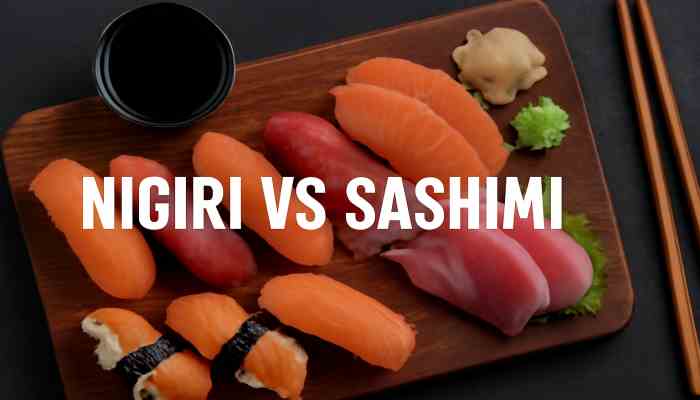Nigiri vs Sashimi: Understanding the Delicious Differences

When it comes to Japanese cuisine, nigiri and sashimi often make appearances together on sushi menus. However, there are some key differences that set them apart. Many people find themselves puzzled by the similarities and distinctions between these two dishes. But once you dive deeper into the specifics, you’ll see that they each have their own unique qualities. Let’s take a closer look at nigiri vs sashimi, and explore what makes them stand out.
Table of Contents
What is Nigiri?

Nigiri is a type of sushi consisting of vinegared rice topped with raw fish or seafood. The rice is hand-pressed into a small, bite-sized mound and topped with a thin slice of fish, such as tuna or salmon. Sometimes, a bit of wasabi is placed between the fish and rice for added flavor. Unlike other sushi forms that may involve wrapping the rice in seaweed, nigiri is served without it.
The art of making nigiri requires a high level of skill. Sushi chefs spend years perfecting the ability to shape the rice perfectly and to press it just right so that it melts in your mouth. It’s a delicate balance of pressure and technique.
What is Sashimi?

On the other hand, sashimi is simply thin slices of raw fish or seafood served without rice. Sashimi is a standalone dish, and it focuses purely on the taste of the fish. Often, it’s served with garnishes like shredded daikon radish or shiso leaves, along with soy sauce or ponzu for dipping.
Unlike nigiri, sashimi is not considered sushi. It’s a raw dish that highlights the pure taste of the fish. It’s all about freshness and the quality of the ingredients. Sashimi can include different types of fish, shellfish, and even proteins like beef or chicken in some cases.
Key Differences Between Nigiri and Sashimi
At first glance, nigiri and sashimi may look similar because they both contain raw fish. However, the differences are significant:
- Serving Style:
- Nigiri: Served with vinegared rice and typically one slice of fish on top.
- Sashimi: Served as thinly sliced raw fish, without rice.
- Ingredients:
- Nigiri: Can include raw fish, but also cooked items like eel or tamago (Japanese omelet).
- Sashimi: Always consists of raw fish or seafood, with no rice involved.
- Portion Size:
- Nigiri: Typically one bite-size piece of fish on top of rice.
- Sashimi: Usually comes in several slices of the same type of fish.
- Cultural Classification:
- Nigiri: Is a type of sushi, and is often served alongside other sushi dishes.
- Sashimi: A standalone dish, though it is often paired with sushi in Japanese meals.
Nigiri vs Sashimi vs Sushi
Now that we’ve explored nigiri vs sashimi, it’s important to note that both of these dishes fall under the broader category of sushi. Sushi refers to any dish that uses vinegared rice, and nigiri is one form of sushi. Sashimi, however, doesn’t involve rice, and is therefore not technically sushi, even though it is often served alongside sushi on menus.
While sushi includes nigiri, maki rolls, and other variations, sashimi is about simplicity – the focus is solely on the raw fish and how it’s prepared. So, when considering nigiri vs sashimi vs sushi, it’s crucial to remember that nigiri is a specific type of sushi, while sashimi is a unique, rice-less dish of raw fish.
Also Check: Texas Roadhouse Family Meals – Big Taste, Small Price 2025
Which is More Expensive?
When it comes to price, sashimi is generally more expensive than nigiri. This is because sashimi requires thicker cuts of fish, and typically includes multiple slices of fish per order. The preparation for sashimi is also more detailed, as the fish needs to be sliced with precision.
Nigiri, being smaller and often served with a single piece of fish, tends to cost less. However, prices can vary depending on the type of fish used. Specialty fish like toro (fatty tuna) or uni (sea urchin) can make both nigiri and sashimi more expensive.
Cultural Significance and Popularity in the U.S.
Both nigiri and sashimi are staples in Japanese cuisine and have found their place in the American food scene. In the U.S., sushi bars and restaurants commonly serve both dishes, though sashimi tends to be more popular in traditional Japanese restaurants, while nigiri is often more widely available in casual sushi spots.
The growing trend of Japanese cuisine in the U.S. has brought a wider appreciation for authentic, high-quality sashimi. Many sushi lovers enjoy sashimi as a way to appreciate the raw, delicate flavors of the fish without the distraction of rice or sauces.
How to Enjoy Nigiri and Sashimi
If you’re new to eating nigiri or sashimi, here are a few tips to enhance your experience:
- Use Soy Sauce Wisely: When eating nigiri, it’s acceptable to dip only the fish in soy sauce, not the rice. For sashimi, you can dip the fish in soy sauce or ponzu, but don’t drench it. The idea is to let the fish’s natural flavor shine.
- Eat with Fingers or Chopsticks: Nigiri is traditionally eaten with fingers, but you can use chopsticks if you prefer. Sashimi is generally eaten with chopsticks.
- Try Wasabi: Adding a small amount of wasabi to either dish can bring a nice kick of flavor. But be cautious – wasabi can be quite potent.
Frequently Asked Questions (FAQs)
1. What is the difference between nigiri and sashimi?
Nigiri is a type of sushi that consists of vinegared rice topped with a slice of raw fish or seafood. Sashimi, on the other hand, is just thinly sliced raw fish or seafood, served without rice.
2. Can you eat nigiri with your fingers?
Yes, nigiri is traditionally eaten with your fingers, though you can use chopsticks if you prefer. The important thing is to handle it gently to keep the rice intact.
3. Is sashimi raw fish only?
Yes, sashimi is typically made with raw fish or seafood, although in some cases, other proteins like beef or chicken are used.





